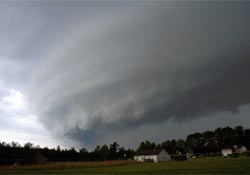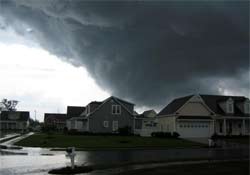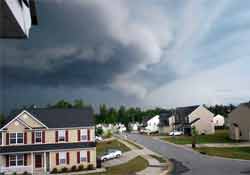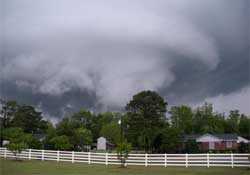News and Site Updates Archive 2009/05/16
Never before in modern times has so much of the world been simultaneously hit by a confluence of economic and financial turmoil such as we are now living
through.
- Timothy Geithner
  16 May
2009 - The Little Red Spot on Jupiter (left, lower, orange) is an anti-cyclonic storm formed
by 3 separate storms, observed since the 1930s, merging. In 1998 two of them came together; they were joined in 2000 by a 3rd to form a storm roughly the size of Earth. In 2005 it began turning red
for unknown reasons and now looks similar to its larger, more famous neighbour, the Great Red Spot. This storm has some of the highest wind speeds ever detected on any planet - peak speed exceeds 384
miles per hour. Unlike hurricanes, which rotate around a centre of low pressure, anti-cyclones rotate around centres of high pressure. On Earth that means that air at lower elevations is forced away
from the centre, creating an opening that pulls cold air down from above, leading to low humidity and few clouds; anticyclones often predict fair weather, though special conditions can create anti-cyclonic
tornadoes. There have been instances of anti-cyclonic storms on Jupiter, Saturn, and Neptune... The moon's surface becomes electrified during each full moon. The moon passes through the earth's magnetotail,
a cone of highly-charged particles, for about 6 days each month. On the side of the moon facing the sun, ultraviolet particles disrupt the electromagnetic effect keeping the voltage at low levels, but on
the dark side the voltage can reach hundreds or thousands of volts. The last time man walked on the moon was in 1972. NASA has been planning to re-visit the moon by the year 2020 - but this
discovery may put a hold on those plans. Luckily, no astronaut ever landed on a charged-up full moon. 16 May
2009 - The Little Red Spot on Jupiter (left, lower, orange) is an anti-cyclonic storm formed
by 3 separate storms, observed since the 1930s, merging. In 1998 two of them came together; they were joined in 2000 by a 3rd to form a storm roughly the size of Earth. In 2005 it began turning red
for unknown reasons and now looks similar to its larger, more famous neighbour, the Great Red Spot. This storm has some of the highest wind speeds ever detected on any planet - peak speed exceeds 384
miles per hour. Unlike hurricanes, which rotate around a centre of low pressure, anti-cyclones rotate around centres of high pressure. On Earth that means that air at lower elevations is forced away
from the centre, creating an opening that pulls cold air down from above, leading to low humidity and few clouds; anticyclones often predict fair weather, though special conditions can create anti-cyclonic
tornadoes. There have been instances of anti-cyclonic storms on Jupiter, Saturn, and Neptune... The moon's surface becomes electrified during each full moon. The moon passes through the earth's magnetotail,
a cone of highly-charged particles, for about 6 days each month. On the side of the moon facing the sun, ultraviolet particles disrupt the electromagnetic effect keeping the voltage at low levels, but on
the dark side the voltage can reach hundreds or thousands of volts. The last time man walked on the moon was in 1972. NASA has been planning to re-visit the moon by the year 2020 - but this
discovery may put a hold on those plans. Luckily, no astronaut ever landed on a charged-up full moon.
  Who is this mystery
man?... A rare neurodevelopmental disorder, Williams syndrome, first identified in 1961 by Dr J C P Williams of NZ, is
caused by a deletion of about 26 genes from the long arm of chromosome 7. Characterised by a distinctive, "elfin" facial appearance, an unusually cheerful demeanor, ease with strangers, unusual language
skills, a love for music, and often cardiovascular problems, individuals with Williams are highly verbal and sociable (having what has been described as a "cocktail party" type personality) but lack common
sense and typically have inhibited intelligence. They hyperfocus on the eyes of others in social engagements, tend to have widely spaced teeth, a long vertical groove in the midline of the upper lip
(philtrum), and a flattened nasal bridge. Adult stature is slightly smaller than average; they often have hyperacusis (extra-acute hearing), are likely to possess perfect pitch and to be left-handed. They have problems with visual
processing (related to difficulty in dealing with complex spatial relationships rather than to issues with depth perception) and report higher anxiety levels and phobia development (especially of thunderstorms
and escalators due to noise and movement). No curative therapy is known; care is mostly supportive. Accelerated ageing is characteristic of Williams adults, possibly related to elastin deletion;
they also have poor dental hygiene and develop diabetes at a higher-than-normal rate. Williams syndrome has an estimated prevalence of 1 in 7,500 to 1 in 20,000. In popular culture, it features in
a 2007 episode of Law & Order: Special Victims Unit entitled "Savant," in which a girl with the condition is the only witness to an attack on her mother; she doesn't see the attacker but hears him
speak and her absolute pitch helps police catch him. In the Wes Anderson film The Royal Tenenbaums, the character Dudley has fictional Heinsbergen Syndrome, which features many similarities with
Williams - he has difficulty understanding spatial relations (dyslexia, colourblindness, inability to solve puzzles) and acute hearing. Who is this mystery
man?... A rare neurodevelopmental disorder, Williams syndrome, first identified in 1961 by Dr J C P Williams of NZ, is
caused by a deletion of about 26 genes from the long arm of chromosome 7. Characterised by a distinctive, "elfin" facial appearance, an unusually cheerful demeanor, ease with strangers, unusual language
skills, a love for music, and often cardiovascular problems, individuals with Williams are highly verbal and sociable (having what has been described as a "cocktail party" type personality) but lack common
sense and typically have inhibited intelligence. They hyperfocus on the eyes of others in social engagements, tend to have widely spaced teeth, a long vertical groove in the midline of the upper lip
(philtrum), and a flattened nasal bridge. Adult stature is slightly smaller than average; they often have hyperacusis (extra-acute hearing), are likely to possess perfect pitch and to be left-handed. They have problems with visual
processing (related to difficulty in dealing with complex spatial relationships rather than to issues with depth perception) and report higher anxiety levels and phobia development (especially of thunderstorms
and escalators due to noise and movement). No curative therapy is known; care is mostly supportive. Accelerated ageing is characteristic of Williams adults, possibly related to elastin deletion;
they also have poor dental hygiene and develop diabetes at a higher-than-normal rate. Williams syndrome has an estimated prevalence of 1 in 7,500 to 1 in 20,000. In popular culture, it features in
a 2007 episode of Law & Order: Special Victims Unit entitled "Savant," in which a girl with the condition is the only witness to an attack on her mother; she doesn't see the attacker but hears him
speak and her absolute pitch helps police catch him. In the Wes Anderson film The Royal Tenenbaums, the character Dudley has fictional Heinsbergen Syndrome, which features many similarities with
Williams - he has difficulty understanding spatial relations (dyslexia, colourblindness, inability to solve puzzles) and acute hearing.
Birth defect rates in the US are highest for women conceiving in the spring and summer. This period of
increase in risk correlates with increased levels of pesticides in surface water. Many of these chemicals, including the herbicide atrazine which is banned in European countries but permitted in the US,
are suspected to be harmful to the developing embryo. This is the first study to link their increased seasonal concentration in surface water with the peak in birth defects in infants conceived in the
same months. Water chlorination is a widely used and efficient method of disinfecting drinking water and
reducing the occurrence of waterborne diseases. However, numerous studies reveal the presence of chlorination by-products in water. Recent research suggests that prenatal exposure to these
by-products increases the risk of birth defects. Whilst the benefits of water chlorination are quite evident, more research is needed to determine side-effects.
What would you do if you found a large amount of money?
Try to return it to the rightful owner
210 votes, 31.9%
Keep it for myself
99 votes, 15.0%
Depends on whether anyone saw me...
57 votes, 8.7%
Take it to the police
284 votes, 43.2%
Give it to charity
8 votes, 1.2%
Total 658 votes |
|
Related story (though the person
in that story didn't find money but rather something - bonds - that required identification to cash in. However, an El Paso
resident discovered a bag lying beside an ATM that was full of money. She said the tag on the bag said there was $120,000 inside but all she did was to ascertain that it indeed contained money,
then she called the police to report her find. If the money remains unclaimed (unlikely), she gets it back. Why not count it? What if someone down the line took
money out and blamed it on her? She'd need to be present when it was first counted. Her fingerprints on the money could perhaps be used as evidence against her if
it proved to be stolen. There are many things to consider when something valuable is involved. Does handling found money make the finder want to keep it? |
A moderate dose of alcohol increases a person's mind wandering, while at the same time it reduces the
likelihood of the drinker noticing that his mind has wandered. This suggests impairment of a psychological state called meta-consciousness. This may explain why alcohol often disrupts efforts to
exercise self-control - a process requiring the ability to become aware of one's current state in order to regulate it. The observation that alcohol increases mind-wandering suggests another reason why
alcohol makes driving dangerous - drinking drivers may lose track of what they are doing. Moreover, the finding that alcohol reduces meta-consciousness may explain why people drive when they are
drunk. By reducing their ability to assess their current state, intoxicated people may fail to realise how intoxicated they are and thus they inadequately appraise the danger of driving.
  Imagine someone who is genuinely hungry, or even has a hungry family, who finds himself walking past an unattended fruit stand. Just
because we might applaud his decision not to steal an apple, it doesn't mean we think theft should be a legal option. Or to take an even more mundane case, picture someone who's driving to an appointment
for which she is late: we could understand why she might be inclined to drive at dangerous speeds - and commend her decision not to do so - without thinking speed limits should be abolished. The fact of
the matter is that even in Sarah Palin's ideal pro-life world, many women will
still have to make the difficult choice of whether or not to have an illegal abortion - just as in the theoretical examples, the hungry man will have to decide whether or not to steal and the tardy woman
will have to decide whether or not to break the speed limit. I prefer a world in which abortion is a legal option. The fact that Palin disagrees doesn't mean she would banish moral decisionmaking
from the world, but rather that she would have the law place a heavy finger on the scale. (What? Can you tell I don't like that person? Why doesn't she GO AWAY? My favourite suggestion for
title for her upcoming book via Alaskan Shannyn Moore: The Lyin', The Witch And The Wardrobe.) In 1853 Queen
Victoria decided to use chloroform during labour - and she would do it again for her next and final (her 9th) delivery). The drug made the hard experience far less painful and she made it known to the
public (or at least the social elite) that anaesthetised labour was a wonderful discovery, a great achievement, a sign of progress. But guess who was upset about the success of Queen Victoria’s
experiment? The Church. Why? Because painless pregnancy was not a part of God’s plan. Indeed, it negated Eve’s curse. God cursed women, and that curse must, for God’s sake,
remain... Mick Jagger slept with an estimated 4,000 women during his 24-year
relationship with Jerry Hall. Imagine someone who is genuinely hungry, or even has a hungry family, who finds himself walking past an unattended fruit stand. Just
because we might applaud his decision not to steal an apple, it doesn't mean we think theft should be a legal option. Or to take an even more mundane case, picture someone who's driving to an appointment
for which she is late: we could understand why she might be inclined to drive at dangerous speeds - and commend her decision not to do so - without thinking speed limits should be abolished. The fact of
the matter is that even in Sarah Palin's ideal pro-life world, many women will
still have to make the difficult choice of whether or not to have an illegal abortion - just as in the theoretical examples, the hungry man will have to decide whether or not to steal and the tardy woman
will have to decide whether or not to break the speed limit. I prefer a world in which abortion is a legal option. The fact that Palin disagrees doesn't mean she would banish moral decisionmaking
from the world, but rather that she would have the law place a heavy finger on the scale. (What? Can you tell I don't like that person? Why doesn't she GO AWAY? My favourite suggestion for
title for her upcoming book via Alaskan Shannyn Moore: The Lyin', The Witch And The Wardrobe.) In 1853 Queen
Victoria decided to use chloroform during labour - and she would do it again for her next and final (her 9th) delivery). The drug made the hard experience far less painful and she made it known to the
public (or at least the social elite) that anaesthetised labour was a wonderful discovery, a great achievement, a sign of progress. But guess who was upset about the success of Queen Victoria’s
experiment? The Church. Why? Because painless pregnancy was not a part of God’s plan. Indeed, it negated Eve’s curse. God cursed women, and that curse must, for God’s sake,
remain... Mick Jagger slept with an estimated 4,000 women during his 24-year
relationship with Jerry Hall.

 Dolphins have a clever way to overcome sleep deprivation: they send half their brain to
sleep while the other half remains conscious. What's more, they're able to remain continually vigilant for days on end. Information learned by one side of the brain is transferred between
the two hemispheres; the inter-hemispheric commissures, which connect the halves, apparently can also transfer visual information. A bottlenose dolphin rescued 2 whales stranded on a beach in NZ - the pygmy sperm whales had beached repeatedly and were
disoriented and exhausted. A semi-tame dolphin (famous locally for playing with swimmers) apparently communicated with the whales, calmed them, then led them to safety along the beach and out to
sea. The whales weren't seen again but the dolphin was observed the following day again playing with the swimmers. A 12-year-old dolphin very badly injured in a shark attack
disappeared with his older dolphin friend. After 3 days, the older dolphin escorted his injured friend back to where humans could take over and repair his injuries - wildlife experts were able to lift
the injured dolphin without a struggle into a boat and take him to the mainland to be treated by vets. A female dolphin was repeatedly observed herding cuttlefish out of algal weed and onto a clear, sandy patch of seafloor. She pinned
one with her snout while standing on its head before killing it instantly with a rapid downward thrust and "loud click" audible to divers as the hard cuttlebone broke. She then lifted the body and beat
it with her nose to drain its toxic black ink. Next, she scraped it along the sand to strip out the cuttlebone, making it soft for eating. A mother dolphin in Western Australia taught her daughters
to break off sea sponges and wear them as protection while scouring the seafloor. Unfortunately, the US Supreme
Court has ruled that US national security concerns trump the environment - though sonar produces noise as loud as 2,000 jet engines and some marine mammals die or become stranded in their frantic efforts to
avoid it, "The whole point of the armed forces is to hurt the environment," said Justice Breyer. "You go on a bombing mission - do they have to prepare an environmental impact statement
first?" Falstaff is a 15-inch orange-and-black koi; Chino is a 9-year-old golden retriever. Chino spends up
to half an hour at a time following the movements of Falstaff and a small school of goldfish. Falstaff, in return, comes over to nibble Chino's paws.
Dolphins have a clever way to overcome sleep deprivation: they send half their brain to
sleep while the other half remains conscious. What's more, they're able to remain continually vigilant for days on end. Information learned by one side of the brain is transferred between
the two hemispheres; the inter-hemispheric commissures, which connect the halves, apparently can also transfer visual information. A bottlenose dolphin rescued 2 whales stranded on a beach in NZ - the pygmy sperm whales had beached repeatedly and were
disoriented and exhausted. A semi-tame dolphin (famous locally for playing with swimmers) apparently communicated with the whales, calmed them, then led them to safety along the beach and out to
sea. The whales weren't seen again but the dolphin was observed the following day again playing with the swimmers. A 12-year-old dolphin very badly injured in a shark attack
disappeared with his older dolphin friend. After 3 days, the older dolphin escorted his injured friend back to where humans could take over and repair his injuries - wildlife experts were able to lift
the injured dolphin without a struggle into a boat and take him to the mainland to be treated by vets. A female dolphin was repeatedly observed herding cuttlefish out of algal weed and onto a clear, sandy patch of seafloor. She pinned
one with her snout while standing on its head before killing it instantly with a rapid downward thrust and "loud click" audible to divers as the hard cuttlebone broke. She then lifted the body and beat
it with her nose to drain its toxic black ink. Next, she scraped it along the sand to strip out the cuttlebone, making it soft for eating. A mother dolphin in Western Australia taught her daughters
to break off sea sponges and wear them as protection while scouring the seafloor. Unfortunately, the US Supreme
Court has ruled that US national security concerns trump the environment - though sonar produces noise as loud as 2,000 jet engines and some marine mammals die or become stranded in their frantic efforts to
avoid it, "The whole point of the armed forces is to hurt the environment," said Justice Breyer. "You go on a bombing mission - do they have to prepare an environmental impact statement
first?" Falstaff is a 15-inch orange-and-black koi; Chino is a 9-year-old golden retriever. Chino spends up
to half an hour at a time following the movements of Falstaff and a small school of goldfish. Falstaff, in return, comes over to nibble Chino's paws.
Almost 22% of homeowners in the US now owe more on their mortgages than their homes are worth. US
homes have depreciated $3.8 trillion in the past 12 months. Some homes in California and Florida have lost more than 50% of their value. H-m-m-m. Years ago, we were buying our younger son a
"really nice" classical guitar (one that could handle harmonics, that had a lengthy resonation period, that had both highs and lows that carried) while selling our older son's 100+-year-old George Cunault
violin. Our older son also had a Bulgarian violin that sounded virtually as good as the Cunault but we were unable to sell the Bulgarian violin because it had no cachet. (Even if someone bought it
and loved it, it might prove difficult for him/her to sell in turn.) So what happened? We made the exchange with no trouble - but my older son, a dilettante musician in any case, stopped playing the
violin altogether because the Bulgarian violin wasn't as much of a pleasure to play. Our younger son loves his guitar and plays it several times a week. It sounds lovely. But we discovered,
when getting it valued for insurance, that it wasn't worth nearly as much as it might've been because the luthier who made it had not signed the label inside. Did this change its sound in any
way? Certainly not. But it did affect its value. What is value? The guitar is still just as loved by my younger son. But, though an accomplished professional violinist told us our
two violins were equivalent in capability and sound, neither my older son nor prospective buyers found them to be equivalent in value. To some, there is more to value, clearly, than mere
utility - or even beauty. People who live in houses that they still love and that they are perfectly willingly to pay for, nevertheless now find their value diminished. Are people so unsure of what
is important to them they they must look to see how other people feel? Or is value only important if you have plans to divest yourself at some point in the future of whatever it is?

Fog is usually grey, but it can come in other colours, including pink, green, lavender, yellow, orange, blue and brown.
I don't know how many of these images are photoshopped - only one admits to it - but they are lovely nonetheless.
US Social Security and Medicare are fading faster than ever under the weight of the recession. Social Security will start paying out more in benefits than it collects in taxes in 2016, a year sooner
than was projected last year, and will be depleted by 2037, 4 years sooner. Medicare is in even worse shape. It will pay out more in benefits than it collects this year, just as it did for the first
time in 2008. Medicare will be depleted by 2017, 2 years earlier than the date projected in last year's report. The trust funds — which exist in paper form in a filing cabinet in Parkersburg, West
Virginia — are bonds that are backed by the government's "full faith and credit" but not by any actual assets. That money has been spent over the years to fund other parts of government. To redeem
the trust fund bonds, the government will have to borrow in public debt markets or raise taxes. Am I missing something here? The US government is already having trouble borrowing after its wild
spending spree for the bailout. So now it will have to raise taxes just to get the money again that's already been paid in once for retirement and medical care? (No, this doesn't come as a
surprise.) Meanwhile, the UN's head of environment has been left "stunned" by the billions of dollars pumped into ailing
companies following the global financial crisis. They waited a decade to get US$5 billion to accelerate development of renewable energy while $20 billion was paid to a car company simply to keep it
alive. Huge amounts had "suddenly been found" to tackle the economic crisis. Well, at least the US has their priorities straight.
 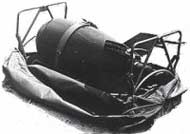 At 54 kilograms and about the diameter of a basketball, it was meant to be used by ground troops as a short range bomb. This teeny nuke, basically able to be held in your hands, could pack the explosive force of 500
tons of TNT. Like, some lieutenant comes to you and says, "if you see the Ruskies coming over that hill, grab this Bazooka with a nuclear warhead at the tip of it and fire towards them. You might
live for a bit afterwards." Hence the name Davy Crockett to inspire the troops to a proper suicidal zeal. The Davy Crockett could be launched from either of two launchers: the 4-inch (102 millimetres) M28, with a range of about 1.25 miles
(2 kilometres), or the 6-inch (155 millimetres) M29, with a range of 2.5 miles (4 kilometres). Both weapons used the same projectile, and could be mounted on a tripod launcher or carried by truck or
armoured personnel carrier. They were operated by a 3-man crew. Both recoilless guns proved to have poor accuracy in testing, so the shell's greatest effect would have been its extreme radiation
hazard. Even at a low yield setting, the M388 would produce an almost instantly lethal radiation dosage (in excess of 10,000 rem) within 500 feet (150 metres), and a probably fatal dose (around 600 rem)
within a quarter mile (400 metres). Production of the Davy Crockett began in 1956, with a total of 2,100 being made. The weapon was deployed with US Army forces from 1961 to
1971. Wee Gwen was a British version designed to kill and incapacitate enemy troops by neutron and gamma radiation,
rather than by blast and heat. The project never proceeded far, the principal reason being internal Service strife, disagreements within the Army, and the critical shortage of fissile material. The
total amount of plutonium required for the full programme of 1,275 warheads amounted to 5,100 kilograms. That amount was never a possibility for the UK given the scarcity and high cost. The US, meanwhile,
began production of the Wee Gnat, which, with a fissile core weighing only 19 pounds, came packaged in its own carry-bag. At 54 kilograms and about the diameter of a basketball, it was meant to be used by ground troops as a short range bomb. This teeny nuke, basically able to be held in your hands, could pack the explosive force of 500
tons of TNT. Like, some lieutenant comes to you and says, "if you see the Ruskies coming over that hill, grab this Bazooka with a nuclear warhead at the tip of it and fire towards them. You might
live for a bit afterwards." Hence the name Davy Crockett to inspire the troops to a proper suicidal zeal. The Davy Crockett could be launched from either of two launchers: the 4-inch (102 millimetres) M28, with a range of about 1.25 miles
(2 kilometres), or the 6-inch (155 millimetres) M29, with a range of 2.5 miles (4 kilometres). Both weapons used the same projectile, and could be mounted on a tripod launcher or carried by truck or
armoured personnel carrier. They were operated by a 3-man crew. Both recoilless guns proved to have poor accuracy in testing, so the shell's greatest effect would have been its extreme radiation
hazard. Even at a low yield setting, the M388 would produce an almost instantly lethal radiation dosage (in excess of 10,000 rem) within 500 feet (150 metres), and a probably fatal dose (around 600 rem)
within a quarter mile (400 metres). Production of the Davy Crockett began in 1956, with a total of 2,100 being made. The weapon was deployed with US Army forces from 1961 to
1971. Wee Gwen was a British version designed to kill and incapacitate enemy troops by neutron and gamma radiation,
rather than by blast and heat. The project never proceeded far, the principal reason being internal Service strife, disagreements within the Army, and the critical shortage of fissile material. The
total amount of plutonium required for the full programme of 1,275 warheads amounted to 5,100 kilograms. That amount was never a possibility for the UK given the scarcity and high cost. The US, meanwhile,
began production of the Wee Gnat, which, with a fissile core weighing only 19 pounds, came packaged in its own carry-bag.
  In 1971, the Cannikin bomb, a 300-foot-long device implanted in a mile-deep hole under
Cannikin Lake on Amchitka Island in Alaska, exploded with the force of an earthquake registering 7.0 on the Richter Scale. The blast shock scooped a mile-wide, 60-foot-deep subsidence crater in the
ground over the test site, triggering massive rockfalls. Immediate ecological damage was staggering: nearly 1,000 sea otters (once hunted to near extinction) were killed, their skulls crushed by
shockwaves. Other marine mammals died when their eyes were blown out of their sockets or their lungs ruptured. Thousands of birds also perished, spines snapped and legs pushed through their
bodies. (Neither the Pentagon nor the Fish and Wildlife Service has ever studied long-term ecological consequences.) Most worrisome was that a large volume of water from White Alice Creek vanished
after the blast. The disappearance of the creek was more than a sign of Cannikin's horrific power - it was also an indication that the project had gone terribly wrong; the blast ruptured the crust of the
earth, sucking the creek into a brand new radioactive aquifer. Video. For 60 years, soldiers, politicians
and historians have argued about the morality of the atomic bombing of Hiroshima. Did it bring
an end to the war, removing need for a land invasion which would have killed many more civilians and soldiers than the bomb itself? Or was it a cynical test of new weaponry on an enemy already on the
verge of collapse? Whatever moral doubts exist about the bombing of Hiroshima are redoubled in the case of Nagasaki. In the 3 days since the first bomb, no word came from Tokyo suggesting imminent
surrender. But American intelligence was fully aware of the confusion which reigned in the Japanese High Command: the question under debate was not whether, but how, to submit to the
inevitable. With the entry into the Pacific War of the Soviet Union, Japan’s decline was irreversible. "Why did they drop another bomb on Nagasaki?" Mr Yamaguchi asked as we sat in the fruit
garden. "They could have made their point by dropping one bomb. I think they were in a hurry to show their superiority. It would have been one thing had they used it on a
battlefield. But they knew it would kill women, children, babies. How could they do that?" (This is a phenomenally-persistent topic of conversation.) In 1971, the Cannikin bomb, a 300-foot-long device implanted in a mile-deep hole under
Cannikin Lake on Amchitka Island in Alaska, exploded with the force of an earthquake registering 7.0 on the Richter Scale. The blast shock scooped a mile-wide, 60-foot-deep subsidence crater in the
ground over the test site, triggering massive rockfalls. Immediate ecological damage was staggering: nearly 1,000 sea otters (once hunted to near extinction) were killed, their skulls crushed by
shockwaves. Other marine mammals died when their eyes were blown out of their sockets or their lungs ruptured. Thousands of birds also perished, spines snapped and legs pushed through their
bodies. (Neither the Pentagon nor the Fish and Wildlife Service has ever studied long-term ecological consequences.) Most worrisome was that a large volume of water from White Alice Creek vanished
after the blast. The disappearance of the creek was more than a sign of Cannikin's horrific power - it was also an indication that the project had gone terribly wrong; the blast ruptured the crust of the
earth, sucking the creek into a brand new radioactive aquifer. Video. For 60 years, soldiers, politicians
and historians have argued about the morality of the atomic bombing of Hiroshima. Did it bring
an end to the war, removing need for a land invasion which would have killed many more civilians and soldiers than the bomb itself? Or was it a cynical test of new weaponry on an enemy already on the
verge of collapse? Whatever moral doubts exist about the bombing of Hiroshima are redoubled in the case of Nagasaki. In the 3 days since the first bomb, no word came from Tokyo suggesting imminent
surrender. But American intelligence was fully aware of the confusion which reigned in the Japanese High Command: the question under debate was not whether, but how, to submit to the
inevitable. With the entry into the Pacific War of the Soviet Union, Japan’s decline was irreversible. "Why did they drop another bomb on Nagasaki?" Mr Yamaguchi asked as we sat in the fruit
garden. "They could have made their point by dropping one bomb. I think they were in a hurry to show their superiority. It would have been one thing had they used it on a
battlefield. But they knew it would kill women, children, babies. How could they do that?" (This is a phenomenally-persistent topic of conversation.)
A new theory proposes that space itself is the source of the repulsive energy that is pushing the universe
apart. For years scientists assumed that the energy of empty space (vacuum energy) averaged zero, but the discovery of quantum mechanics changed this view. According to quantum theory, empty
space is filled with pairs of "virtual" particles that spontaneously pop into and out of existence too quickly to be detected. This sub-atomic activity is a logical source for dark energy
because both are spread uniformly throughout space. This distribution is consistent with evidence that the average density of dark energy remains constant as the universe expands. This
characteristic is in direct contrast to ordinary matter and energy, which become increasingly dilute as the universe inflates. The new theory attributes dark energy to an entirely new field dubbed
quintessence. Quintessence is comparable to other basic fields like gravity and electromagnetism, but has some unique properties - it is the same strength throughout the universe and acts like an
antigravity agent, causing objects to move away from each other instead of pulling them together like gravity. In its simplest form, the strength of the quintessence field remains constant through time
so that it plays the role of the cosmological constant, a term Albert Einstein added to the theory of general relativity to keep the universe from contracting under the force of gravity.
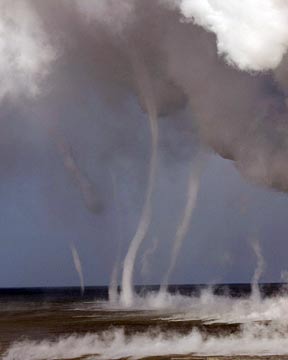 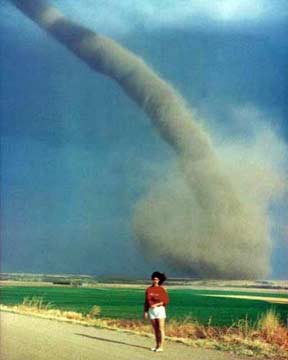 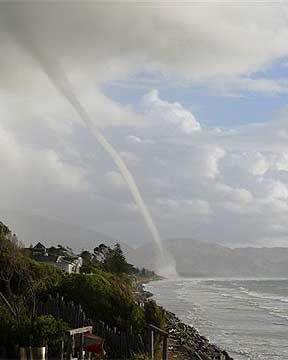 |
|
The world's most active volcano, Kilauea
("much spreading") has continually erupted in Hawaii since 1983; more molten rock than usual flows from an outbreak that started in November. Youngest on Big Island and on the southeastern
side, it has its own magma-plumbing system extending to the surface from more than 60 kilometres deep in the earth. The vortices form from the steam plume at the Waikupanaha ocean entry
point. (See also: Kilauea Volcano Erupts for an impressive video of the eruption. BTW: All volcanoes impress
me.) From Mother Nature Speaks: since 1980, volcanoes have killed more than 30,000
people worldwide and forced evacuation of 1 million people from their homes. |
I'm sorry, but I don't really know anything about this photo - except that it is striking. |
A waterspout hits the beach near Queen Elizabeth Park on the Kapiti Coast. We lived on a boat in Chaffers Marina, for several years. One day I looked outside to see
one of these in the middle of Wellington Harbour off our starboard bow. I had it on good authority that they had little power and that I had nothing to fear except perhaps getting
drenched. Nevertheless, it's an *awesome* sight! (Originally from stuff.co.nz though I didn't capture the date and the link has died. The photo is by
Peter Nicholas.) |
|
Ways not to be jealous or
angry: As Helen Keller put it, "Instead of comparing our lot with that of those who are more
fortunate than we are, we should compare it with the lot of the great majority of our fellow men. It then appears that we are among the privileged." In other words, put things into
perspective. And remember: one person's success doesn't rob another of success. Just do your best. Stay grounded, stay healthy and comfortable; don't be defensive; don't drink; don't expect
praise. Make a joke when you can.
  Ex-US VP Dick Cheney, discussing his approval of the use of
torture, said: "...if you'd look at it from the perspective of a senior government official, somebody like myself, who stood up and took the oath of office on January 20th of ‘01 and raised their right
hand and said we're going to protect and defend the United States against all enemies foreign and domestic, this was exactly, exactly what was needed to do it." Yet here's the actual oath: "I
do solemnly swear (or affirm) that I will support and defend the Constitution of the United States against all enemies, foreign and domestic; that I will bear true faith and allegiance to the same; that
I take this obligation freely, without any mental reservation or purpose of evasion; and that I will well and faithfully discharge the duties of the office on which I am about to enter: So help me
God." A drill sergeant offers 28 rules for gunfighting (in case you ever need to
know). Some of those that impressed me include: • If your shooting stance is good, you're probably not moving fast enough or using cover
correctly. • In 10 years nobody will remember the details of caliber, stance, or tactics. They will only remember who
lived. • If you are not shooting, you should be communicating, reloading, and running. Yell "Fire!" Why "Fire"? Cops will come
with the Fire Department; sirens often scare off bad guys or at least cause them to lose concentration and will - and who is going to summon help if you yell
"Intruder"? • Someday someone may kill you with your own gun, but he should have to beat you to death with it because it is
empty. • Have a backup plan because the first one won't work. "No battle plan ever survives 10 seconds past first contact with an
enemy." • Always tactical load and threat scan 360°. Practice one-handed reloading and off-handed
shooting. That's how you live if hit on your "good" side. • At a practice session, throw your gun into the mud then make sure it still works. You can clean it
later. • Practice shooting in the dark, with someone shouting at you, when out of breath, et cetera. • The only thing you EVER say
afterwards is, "He said he was going to kill me. I believed him. I'm sorry, Officer, but I'm very upset now. I can't say anything more. Please speak with my attorney." Ex-US VP Dick Cheney, discussing his approval of the use of
torture, said: "...if you'd look at it from the perspective of a senior government official, somebody like myself, who stood up and took the oath of office on January 20th of ‘01 and raised their right
hand and said we're going to protect and defend the United States against all enemies foreign and domestic, this was exactly, exactly what was needed to do it." Yet here's the actual oath: "I
do solemnly swear (or affirm) that I will support and defend the Constitution of the United States against all enemies, foreign and domestic; that I will bear true faith and allegiance to the same; that
I take this obligation freely, without any mental reservation or purpose of evasion; and that I will well and faithfully discharge the duties of the office on which I am about to enter: So help me
God." A drill sergeant offers 28 rules for gunfighting (in case you ever need to
know). Some of those that impressed me include: • If your shooting stance is good, you're probably not moving fast enough or using cover
correctly. • In 10 years nobody will remember the details of caliber, stance, or tactics. They will only remember who
lived. • If you are not shooting, you should be communicating, reloading, and running. Yell "Fire!" Why "Fire"? Cops will come
with the Fire Department; sirens often scare off bad guys or at least cause them to lose concentration and will - and who is going to summon help if you yell
"Intruder"? • Someday someone may kill you with your own gun, but he should have to beat you to death with it because it is
empty. • Have a backup plan because the first one won't work. "No battle plan ever survives 10 seconds past first contact with an
enemy." • Always tactical load and threat scan 360°. Practice one-handed reloading and off-handed
shooting. That's how you live if hit on your "good" side. • At a practice session, throw your gun into the mud then make sure it still works. You can clean it
later. • Practice shooting in the dark, with someone shouting at you, when out of breath, et cetera. • The only thing you EVER say
afterwards is, "He said he was going to kill me. I believed him. I'm sorry, Officer, but I'm very upset now. I can't say anything more. Please speak with my attorney."
  Many public health experts remember the 1976 swine flu outbreak that wasn't. Manufacturers raced to
make a vaccine and 40 million Americans were vaccinated amid a monster public relations campaign. But the flu never spread. "One big difference between then and now was that when the swine flu was
detected in 1976, it was found at a single military installation in Ft Dix, New Jersey," said Dr Harvey Fineberg, president of the Institute of Medicine and author of The Epidemic that Never
Was. "In the ensuing weeks and months it was not detected elsewhere - not elsewhere in New Jersey, not elsewhere in the US, not elsewhere in the rest of the world." Worse yet, some people
developed a rare neurological reaction to the vaccine called Guillain-Barre syndrome. Even now, a considerable minority of people believe that vaccines are harmful and refuse to have another. The
American Academy of Neurology estimates that over 30 million Americans suffer from migraine, a syndrome
characterised by recurrent, often excruciating headaches. This is about 10% of the population. I wonder it that percentage holds true in other parts of the world or if the US has more headaches than
other people. When I googled to find that out, I ran across a surprising fact: migraine prevalence in the US is strongly inversely associated with household income; prevalence in the lowest income
group was more than 60% higher than in the 2 highest income groups. Also women have 3 times as many migraines as men. More people in Canada seem to have migraines - about 16% - and the ratio of men
to women is the same - but they don't have a rich/poor divide there. Migraines seem to run in families so there is some genetic basis. Asians have fewer migraines than other groups. The
National Headache Foundation estimates that migraine causes 157 million lost workdays each year due to pain and associated symptoms, resulting in a $13 billion burden to American employers. A new
therapy, called transcranial magnetic stimulation or TMS, uses magnetic pulses to treat chronic migraine sufferers. The migraine aura responds to magnetic stimulation because TMS therapy blocks the wave
of neuronal excitation, a biological system through which neurons become stimulated to fire. The focused magnetic pulse passes noninvasively through the skull inducing an electric current to disrupt the
abnormal brain waves associated with migraine. Women may have more migraines, but they are well known to be able to respond
more robustly to infections, and to recover more quickly - than men (so they die less readily from the flu). Many public health experts remember the 1976 swine flu outbreak that wasn't. Manufacturers raced to
make a vaccine and 40 million Americans were vaccinated amid a monster public relations campaign. But the flu never spread. "One big difference between then and now was that when the swine flu was
detected in 1976, it was found at a single military installation in Ft Dix, New Jersey," said Dr Harvey Fineberg, president of the Institute of Medicine and author of The Epidemic that Never
Was. "In the ensuing weeks and months it was not detected elsewhere - not elsewhere in New Jersey, not elsewhere in the US, not elsewhere in the rest of the world." Worse yet, some people
developed a rare neurological reaction to the vaccine called Guillain-Barre syndrome. Even now, a considerable minority of people believe that vaccines are harmful and refuse to have another. The
American Academy of Neurology estimates that over 30 million Americans suffer from migraine, a syndrome
characterised by recurrent, often excruciating headaches. This is about 10% of the population. I wonder it that percentage holds true in other parts of the world or if the US has more headaches than
other people. When I googled to find that out, I ran across a surprising fact: migraine prevalence in the US is strongly inversely associated with household income; prevalence in the lowest income
group was more than 60% higher than in the 2 highest income groups. Also women have 3 times as many migraines as men. More people in Canada seem to have migraines - about 16% - and the ratio of men
to women is the same - but they don't have a rich/poor divide there. Migraines seem to run in families so there is some genetic basis. Asians have fewer migraines than other groups. The
National Headache Foundation estimates that migraine causes 157 million lost workdays each year due to pain and associated symptoms, resulting in a $13 billion burden to American employers. A new
therapy, called transcranial magnetic stimulation or TMS, uses magnetic pulses to treat chronic migraine sufferers. The migraine aura responds to magnetic stimulation because TMS therapy blocks the wave
of neuronal excitation, a biological system through which neurons become stimulated to fire. The focused magnetic pulse passes noninvasively through the skull inducing an electric current to disrupt the
abnormal brain waves associated with migraine. Women may have more migraines, but they are well known to be able to respond
more robustly to infections, and to recover more quickly - than men (so they die less readily from the flu).
No one can miss a day — a minute, even — of work, carpooling, volunteering, vacation, anything. "I don’t
have time to be sick!" my patients wail. Everyone must soldier on, leaving sick days to those with less important things to do. And many patients aren’t satisfied with sympathy and friendly
advice. They have come to the office for that little piece of blue paper, the antibiotic prescription. "I would never ask for this under normal circumstances," I’m told — except (pick one) I’m
getting married tomorrow; leaving for a month in the Amazon; having 25 houseguests for the weekend. Never mind that antibiotics are useless in treating colds and viral illnesses, and that they have their
own dangers and side effects. Some doctors will write the prescription just to get on with their day. I have done this and know plenty of other physicians who have — much as we may resent being
bullied and feel we’ve failed in our duty to "first, do no harm." In fact, we may very well be doing harm. Beyond the possible side effects and allergic reactions, the nonchalant use of antibiotics
in the community has helped lead to the rise of the drug-resistant bacteria known as superbugs. If the swine flu epidemic ever swings into full gear, I will be prepared for the onslaught of ill
patients. I will educate them about the appropriate use of antibiotics. I will provide symptomatic relief when I can. And I will let them know it’s okay to be sick. It’s okay to stay
home from work, pull up the covers and drink gallons of hot tea all day.
350 photos sent in to Raleigh/Durham's station WRAL by members of the public
during the 5 May 2009 North Carolina storm. My favourite photos included these. I lived in North Carolina for several years and saw many attention-getting
atmospheric disturbances, so I could relate to this.
 | Wendell, North Carolina. Pea-sized hail fell immediately after photo was taken. |
 | Lake Wendell Rd in Johnston County between Wendell and Archer's Lodge |
 | Rotation near Cary High |
 | Wendell |
 | Nash County 1 mile NE of Rocky Mount/Wilson Airport Rotating clockwise |
 | Rocky Mount Wilson Airport |
 | Southern sky Hwy 124 Beth Eden Ct Rocky Mount |
 | Location unspecified |
 | Between Sharpsburg and and Highway 97
|
|
The pilot notified controllers that the plane was at 9,000 feet and climbing. However, a controller
at the centre tried twice to raise the pilot after that and received no response. After a few moments, a different voice came over the radio: passenger Doug White told air traffic controllers the pilot
was unconscious and they needed help. His wife and 2 teenage daughters were flying home to Louisiana with him, he said. White told air traffic controllers it appeared the pilot had died; the plane's
autopilot was on and the plane was continuing to climb. According to the most recent report, which covers the year 2007, out of 22 million general aviation flight hours, an estimated 15 million to 20
million flights, only 6 instances of a pilot's medical incapacitation were reported - but In 4 of those instances, the pilot died.
  I posted a link on this page in December about a 30-year-old Washington, DC orangutan named Bonnie who had learned to whistle from her keeper. I now see where
a 14-year-old German orangutan named Ujian has had a recording made of his whistling. Pictures of them both show
them pressing against the confines of their cages. Most animals - certainly from spiders on up - respond to attention. I see this in my cats. I saw it in the garden spider who learned
to take live moths from my fingers. The problem with raising the consciousness of an animal is, of course, that they become dependent on the stimulation and become really bored without
it. Musician Christian Wolf, one of the producers of Ujian's song, was passing Ujian's enclosure one day while visiting the zoo with his son. Christian stopped in amazement when he heard the animal
whistling. Ujian was inspired to start after a vegetable delivery man was late coming to his cage. Ujian let out an exasperated whistle in a bid to get him to hurry up. From simple notes, the
gifted ape soon graduated to melodic phrases. (He also paints pictures.) Video... Entomophagy means eating
insects as food. Scientists claim adding insects to our diet would be good for us and also for the
environment. Eating insects would provide us with a nutrient-rich diet, would help reduce pests and would put less strain on the planet than eating conventional meat. Some insects in their dried
form are said to have twice the protein of raw meat and fish, while others are rich in unsaturated fat and contain important vitamins and minerals. More. I posted a link on this page in December about a 30-year-old Washington, DC orangutan named Bonnie who had learned to whistle from her keeper. I now see where
a 14-year-old German orangutan named Ujian has had a recording made of his whistling. Pictures of them both show
them pressing against the confines of their cages. Most animals - certainly from spiders on up - respond to attention. I see this in my cats. I saw it in the garden spider who learned
to take live moths from my fingers. The problem with raising the consciousness of an animal is, of course, that they become dependent on the stimulation and become really bored without
it. Musician Christian Wolf, one of the producers of Ujian's song, was passing Ujian's enclosure one day while visiting the zoo with his son. Christian stopped in amazement when he heard the animal
whistling. Ujian was inspired to start after a vegetable delivery man was late coming to his cage. Ujian let out an exasperated whistle in a bid to get him to hurry up. From simple notes, the
gifted ape soon graduated to melodic phrases. (He also paints pictures.) Video... Entomophagy means eating
insects as food. Scientists claim adding insects to our diet would be good for us and also for the
environment. Eating insects would provide us with a nutrient-rich diet, would help reduce pests and would put less strain on the planet than eating conventional meat. Some insects in their dried
form are said to have twice the protein of raw meat and fish, while others are rich in unsaturated fat and contain important vitamins and minerals. More.
  Most parents and adult children experience at least some tension and aggravation with one another, a new
study says. The parent-child relationship is one of the longest-lasting social ties human beings establish, often highly positive and supportive but commonly it includes feelings of irritation, tension
and ambivalence. Researchers asked about tensions related to personality differences, past relationship problems, children's finances, housekeeping habits, lifestyles, and how often they contact each
other. Parents generally report more intense tensions than children particularly regarding the children's lifestyle or behaviour (finances, housekeeping). Tensions may upset parents more than
children because parents have more invested in the relationship. Parents are also concerned with launching children into successful adulthood. Both mothers and fathers report more tension in
relationships with daughters - probably because they have a closer relationship with them. Both adult sons and adult daughters report more tension with mothers than fathers - particularly regarding
personality differences and unsolicited advice - perhaps because mothers make more demands for closeness. Tensions increase with the age of the child because older (middle-aged) children are busier and
have issues with their own children. Increased tension causes yelling or avoidance which only makes things worse... Teaser
trailer for the latest Pixar animation movie, Up (to which release I eagerly look forward)... What do Christian Bale and Kermit the Frog have in common? More than you might think... Most parents and adult children experience at least some tension and aggravation with one another, a new
study says. The parent-child relationship is one of the longest-lasting social ties human beings establish, often highly positive and supportive but commonly it includes feelings of irritation, tension
and ambivalence. Researchers asked about tensions related to personality differences, past relationship problems, children's finances, housekeeping habits, lifestyles, and how often they contact each
other. Parents generally report more intense tensions than children particularly regarding the children's lifestyle or behaviour (finances, housekeeping). Tensions may upset parents more than
children because parents have more invested in the relationship. Parents are also concerned with launching children into successful adulthood. Both mothers and fathers report more tension in
relationships with daughters - probably because they have a closer relationship with them. Both adult sons and adult daughters report more tension with mothers than fathers - particularly regarding
personality differences and unsolicited advice - perhaps because mothers make more demands for closeness. Tensions increase with the age of the child because older (middle-aged) children are busier and
have issues with their own children. Increased tension causes yelling or avoidance which only makes things worse... Teaser
trailer for the latest Pixar animation movie, Up (to which release I eagerly look forward)... What do Christian Bale and Kermit the Frog have in common? More than you might think...
Economic progress, in capitalist society, means turmoil.
- Joseph A Schumpeter

For other updates click "Home" (for the latest) or "Next" (for older) below
|
 Animals
Animals Animation
Animation Art of Playing Cards
Art of Playing Cards Drugs
Drugs Education
Education Environment
Environment Flying
Flying History
History Humour
Humour Immigration
Immigration Info/Tech
Info/Tech Intellectual/Entertaining
Intellectual/Entertaining Lifestyles
Lifestyles Men
Men Money/Politics/Law
Money/Politics/Law New Jersey
New Jersey Odds and Oddities
Odds and Oddities Older & Under
Older & Under Photography
Photography Prisons
Prisons Relationships
Relationships Science
Science Social/Cultural
Social/Cultural Terrorism
Terrorism Wellington
Wellington Working
Working Zero Return Investment
Zero Return Investment



















